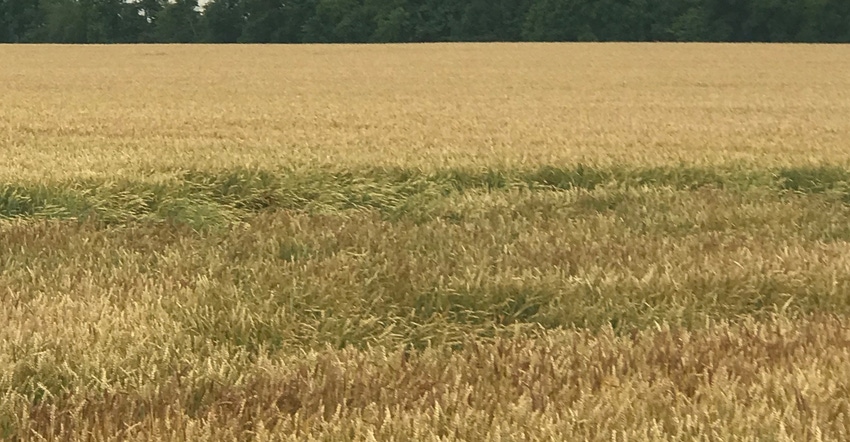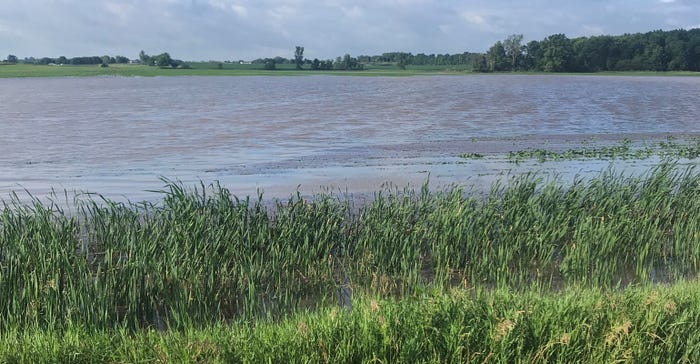
The rain and wind damage caused by June 26 storms that covered most of Lower Michigan may be most prevalent in wheat, which was largely ready to be harvested.
Winter wheat condition dipped to 59% of the crop rated in good-to-excellent condition in the USDA June 28 Crop Report, down from 63% in those categories a week earlier. Heavy rains caused some wheat to lie down and standing water to accumulate.
Much of the wheat crop south of St. Johns and Ithaca areas had reached physiological maturity (PM), says Dennis Pennington, Michigan State University wheat systems specialist.
For fields that reached PM before the rain, the rain will not help yields, he says. For fields that are still green and in the grain fill period, rain will help fill kernels, which will improve yield and test weight.
“The two biggest concerns right now are lodging and sprouting,” Pennington says. “Lodging is widespread across the state — most fields have at least some lodging.”
Lodging late in the grain fill period (close to PM) will not reduce yields significantly, as long as farmers can pick up the downed grain, he notes.
“In some areas of the state [southwest primarily], wheat lodged before reaching PM, which will result in yield loss and lower test weight,” Pennington says. “In addition, downed wheat can be a reservoir for disease and deer damage, including fecal matter.”
Sprout is usually a concern for white wheat growers, although some red varieties also are prone to sprout. With sprout, timing matters — if continuous rainfall occurred before PM, sprout risk is low, Pennington says. Conversely, as wheat moves from PM through ripening, sprout risk keeps going up.
“So, wheat that is just reaching PM now, there’s probably not much risk for sprout unless we keep getting frequent rains,” Pennington says. “Much of the Thumb is near PM, so some early-maturing varieties could be at risk and should be scouted and sampled.”
Growers should work with their local elevators to see if they can run the falling numbers test, he advises. Wheat confirmed with low FN should be segregated from the good grain.
“Damage from sprout will be sporadic across the state and within each field,” Pennington adds. “Areas to be concerned about are sandy areas that dried up early due to drought. Scout fields to identify areas that dried down prematurely, and check for sprout. A FN test may be needed because you can’t always see the sprout with the naked eye.”
The third problem reported with wheat is “black wheat.” “This is most likely black sooty mold, which is a saprophyte on wheat and tends to move in on wheat that has dried down prematurely due to the drought,” Pennington says. “Sooty mold itself does not hurt yields or quality, but it tends to infect wheat that has been damaged from something else.”
Corn and soybean conditions improved because of the rain. Corn went from 57% good-to-excellent condition in the June 21 report to 60% in those categories in the June 28 report. Soybeans went from 57% to 59% in those same categories and time frame.
Untiled fields with heavier soil were holding water, which caused damage in some areas, the report noted.
Soybean outlook
Weather patterns in Michigan continue to be a story of the haves and have-nots, says Janna Fritz, chief executive officer at Michigan Soybean Committee.
“With the excessive rain we had recently, the conversation shifted to having too much rain rather than the past month of not having enough rain,” she says. “We are hearing the vast majority of farms desperately needed this rainfall, and the ground is absorbing the water well in most areas.
“Some areas, however, namely around the Lansing and Grand Rapids areas, saw upwards of 6 or more inches and have soybeans underwater. We will be watching these areas closely over the next few days to see how the crop reacts, and if we expect there to be any long-term damage impacting yields.”

TIME WILL TELL: This soybean field looks more like a lake after a June 26 storm dumped several inches of rain. Time will tell how much of this stand will survive. This photo was taken on the Motz Farm in St. Johns in Clinton County.
Fritz says she is optimistic about this year’s soybean crop, with favorable weather providing decent soil conditions and an opportunity to plant soybeans early in the season.
“We had reports of deeper-than-usual planting depths in drier areas, but overall emergence was good throughout the state,” she says. “Early drought conditions should likely have little effect on the crop yield. We will be watching precipitation totals through late July and most of August to assess the true yield potential of this year’s crop.”
Corn outlook
Depending on the location in Michigan, the recent rains really boosted corn plant growth, says Jim Zook, executive director of Michigan Corn Growers Association and Corn Marketing Program of Michigan.
“In most areas, the corn plant is looking very well,” he says. “However, what we don't know is where we received an abundance of rain, how much of that crop is affected because of ponding of water, which we can't see because of the growth of the plant at this point.”

SUBMERGED CORN: Some later-planted and less-advanced corn may also suffer.
Unlike 2019, when Michigan and surrounding states got so much water it prevented planting, this year’s crop went in the ground quickly and without much trouble, Zook says.
“The soil conditions during planting were the best we've seen in a long time,” Zook says. “We have excellent stand counts. We did have a bit of a setback and injury with frost, though.”
With the lack of rain that followed, corn plants sent down roots to seek moisture, he says. “We believe we've got a good base foundation for the corn plant.”
With the recent rain events, Zook thinks the current moisture level will carry the corn crop through the middle of July, depending on the temperature. “We could be set up for a very good yield,” he says cautiously. “But again, it all depends on how much more rain we get. There seems to be a lot of variability.”
About the Author(s)
You May Also Like






